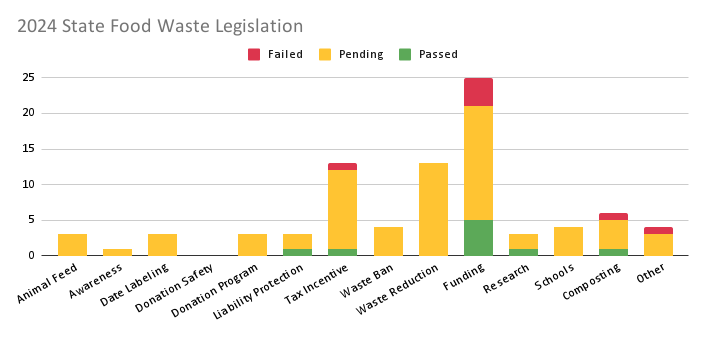By: Josephine Dudzik and Denae Romero (FLPC 2024 Summer Interns)
In June of 2024, the Biden-Harris Administration released its National Strategy for Reducing Food Loss and Waste and Recycling Organics, which provides a list of planned activities for the U.S. to meet the goal of a 50% reduction in food loss and waste by 2030. This coordinated effort between the U.S. Department of Agriculture (USDA), U.S. Environmental Protection Agency (EPA), and U.S. Food and Drug Administration (FDA) aims to develop, implement, and support both federal and state-level programs intended to prevent food loss and waste, increase recycling rates for organic waste, and support policies incentivizing food loss and waste prevention and organic waste recycling. With strategic goals spanning from federal programs to household-level initiatives, this report will undoubtedly shape and guide future efforts to reduce domestic food waste in the U.S.
Aligned with the reinvigorated national focus on reducing food loss and waste, partners ReFED and the Harvard Law School Food Law and Policy Clinic are continuing their biannual update of the Food Waste Policy Finder, an online resource that largely focuses on domestic food waste legislation enacted at the state level, with some grounding analysis of federal policies.
Trends in Domestic Food Waste Legislation
Thus far in 2024, 13 unique federal bills addressing domestic food waste are pending before Congress with none passed. Most of these bills were introduced to shape the Farm Bill, an omnibus piece of legislation which governs much of our food and agricultural systems and must be renewed every five years. Though the Farm Bill was due to be renewed in 2023, the negotiations process has been delayed due to increased partisanship and in anticipation of the November election. Once things settle after the election, Congress may be in a better position to move the Farm Bill forward and to build in these proposals to further strengthen the federal government’s approach to food loss and waste.
On a state level, 22 states have proposed 85 pieces of food waste-related legislation, of which 69 remain pending, 9 have passed, and 7 have failed. New Jersey leads in proposed food waste legislation with 18 introduced bills, followed by California with 10. So far, only 10% of proposed state-level bills have been passed compared to 24% at this point in last year’s legislative cycle. 80% of proposed legislation remains pending and may move as a handful of states wrap up their 2024 legislative sessions in the coming months.
Categorical trends in proposed domestic food waste legislation that support the objectives outlined in the newly released National Strategy can be seen in the figure below.

Breakdown of Different Types of Food Waste Bills:
Each category of bill in the chart above reduces food waste in a different way, allowing states to develop policy solutions that best address their jurisdiction’s concerns. The following are examples of bills from different categories and states accompanied by explanations of how each bill contributes to reducing food waste.
Funding Bills:
Washington HB 2301 was passed in March this year and will provide funding for a grant program through the Center for Sustainable Food Management. This grant program will support activities that reduce emissions from landfills by diversion of organic materials and preventing food waste while increasing food rescue and recovery. Funding will be awarded based on where the project falls in the priority programs listed in the bill. The top priority projects are those that prevent surplus of unsold and uneaten food and improve transportation and storage of donated foods.
Funding bills, such as Washington HB 2301, create incentives for corporations and organizations to improve and increase food waste reduction efforts. This approach sparks innovation for creative solutions within the parameters and goals set forth by the funding requirements.
Date Labeling Bills:
Resolution CA AJR10 was passed in July and calls on the federal government to enact the federal Food Date Labeling Act of 2023, and to recognize that efforts must be accelerated to ensure food is not wasted due to confusing date labeling.
State date labeling policy efforts can only go so far without Federal legislation. Because food travels across state borders, even if one state’s policies clarify and standardize date labels, other states might not, creating a confusing patchwork of date labeling regulations. Inconsistencies in date label laws lead to food waste as consumers concerned with food safety discard wholesome food after the date on the package has passed. Additionally, food businesses discard food due to uncertainty about selling or donating past-date food. Therefore, calling on the federal government to simplify and standardize date labeling requirements sends an important message that states support a federal solution.
Organic Waste Bans Bills:
New York SB 5331would expand the existing food donation and food scraps recycling program by scaling down the annual average tonnage requirement every two years until 2028. This bill limits exceptions afforded to some waste generators by requiring large food waste generators that are within 50 miles of an organics recycler (as opposed to the 25 miles in previous legislation) to comply with the recycling requirements set forth in this bill. Currently the bill has gone through both chambers and has been returned to the Senate for review of amendments made.
Maine LD 1009would prohibit the disposal of surplus food and food scraps in landfills or incinerators and instead direct that food be managed in the following order of priority: reduce the volume of surplus food generated, donate surplus food for human consumption, divert surplus or scrap food for agricultural use, compost or anaerobically digest food scraps to be used for soil application, and lastly, anaerobically digest food scraps for non-soil uses. In March, the legislature passed the bill which still must be funded and signed by the governor before it becomes law. The bill has been carried over to the next biennial legislative session which will begin in early January 2025.
Organic waste bans and organic waste reduction laws not only compel food waste generators to divert their food waste on the back end through recycling food scraps, but these laws also focus attention on food waste prevention. In states where food businesses are required to manage food according to a set of food waste priorities, food businesses must investigate where along their production chain food is wasted and resolve it.
Conclusion
The number of bills introduced and passed in 2024 exhibits the momentum around reducing food loss and waste. Furthermore, the coordinated effort between the USDA, EPA, and FDA in the National Strategy for Reducing Food Loss and Waste and Recycling Organics reflects the growing awareness that reducing food waste is a key component of also reducing climate change, hunger, and food insecurity. While there remains progress to be made to reduce food loss and waste in half by 2030, if this year is a glimpse of the change to come, then there is much to celebrate.
Explore existing food waste reduction policies on the Policy Finder.


